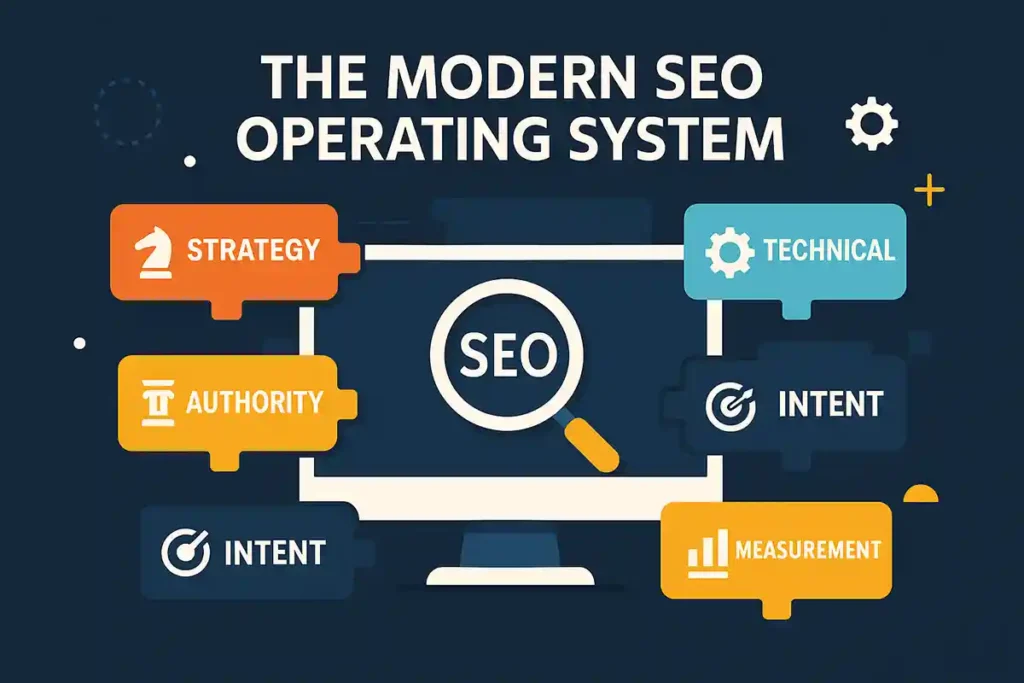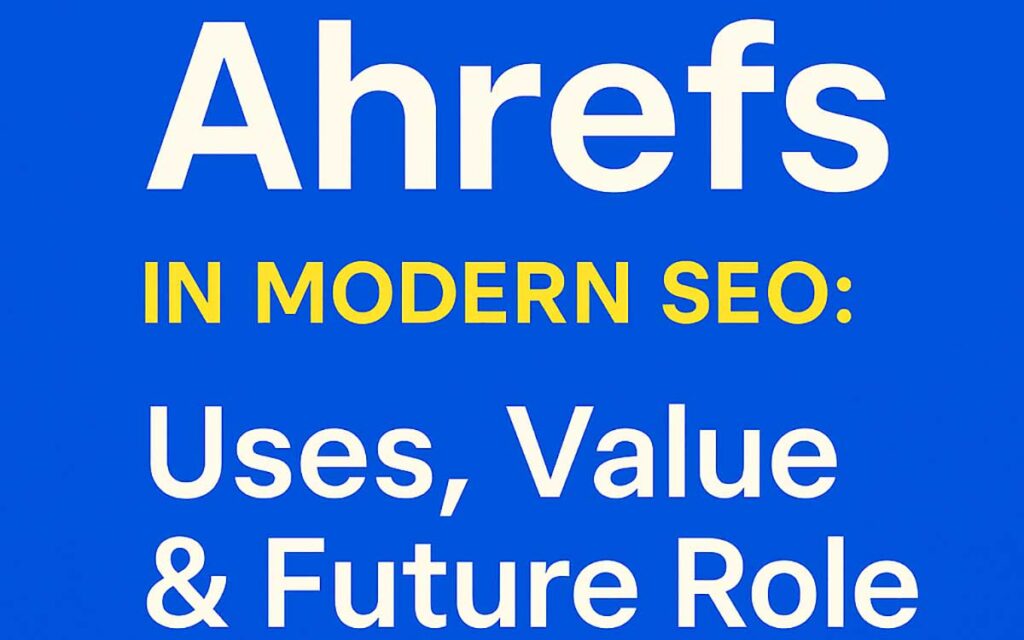Why We Need a Modern SEO Operating System
For years, SEO advice boiled down to a handful of tactics: add keywords, get backlinks, make pages load faster. That approach doesn’t cut it anymore.
Today’s search environment is fragmented. You’re not just fighting for blue-link rankings — you’re competing with AI Overviews, shifting user intent, and machine-driven authority signals.
This raises a key challenge for independents, SMEs, and corporates alike:
- Independents often spread themselves too thin, wasting budget on work that never connects to revenue.
- SMEs risk plateauing because they defend everything without knowing when to attack.
- Corporates spend millions on scale, yet fail to earn the quotes and trust signals that AI systems surface.
The answer isn’t more random tactics. It’s an operating system: a model that shows what to prioritise, why it matters, and how to act.
This article introduces that model, explains each lever, and links you to deeper resources in our SEO library when you’re ready to drill down.
The Five Levers of Modern SEO
Every sustainable SEO strategy in 2025 rests on five levers:
- Strategy – Deciding what to defend and what to attack
- Technical – Ensuring crawl and page performance both support visibility
- Authority – Building trust signals beyond backlinks
- Intent – Optimising for being quoted as well as ranked
- Measurement – Linking SEO activity directly to leads and revenue
Let’s work through each lever with why it matters, what you should do, and how to apply it at different business scales.
Lever 1: Strategy — Defend vs Attack
Why It Matters
Without a clear strategy, SEO becomes a treadmill: endless optimisation with little direction. Businesses either over-defend low-value pages or chase volatile keywords that never convert.
I’ve seen independents in Bournemouth waste half their ad-hoc budgets defending blog posts that generated zero enquiries. At the same time, corporates with teams of 20 still missed their most profitable product queries because nobody “owned” the attack side.
What to Do
Separate your work into two categories:
- Defend: Protect brand searches, profitable service terms, and AI citations you already own.
- Attack: Pursue gaps where intent is clear, margins are high, or competitors are weak.
How to Apply It
Defend vs Attack — Decision Table
| Situation | What it means | Do this | Avoid this |
| Branded searches slipping | Competitors hijack your brand | Defend with FAQs, reviews, profiles | Don’t overspend if brand demand is flat |
| Profitable product invisible | Blind spot in pipeline | Attack with new cluster | Don’t attack if fulfilment is capped |
| Competitor quoted in AI | You rank, they get the credit | Defend authority, attack with evidence | Don’t rewrite without new proof |
| Rankings volatile | High churn in SERPs | Defend edges, attack stable long-tails | Don’t chase every swing |
For practical planning, see how to balance defensive and offensive SEO and why building search resilience is now critical.
By Business Size
- Independents: One defend, one attack. If you can’t deliver it within a week, park it.
- SMEs: Run a two-track backlog: monthly “defend hygiene” sprints, quarterly “attack projects”.
- Corporates: Assign “owners” for defend surfaces (brand SERP, reviews, profiles). Run cross-BU attack plays tied to pipeline KPIs.
Lever 2: Technical — Crawl vs Page Performance
Why It Matters
Google can’t reward what it can’t crawl. Yet most businesses confuse page speed (what users feel) with crawl speed (what bots can access).
One Dorset retailer I worked with shaved milliseconds off LCP but ignored crawl traps in their product filters. Result: Google never reached 40% of their catalogue.
What to Do
- Fix page performance: optimise LCP, CLS, INP, minimise bloat.
- Fix crawl performance: remove traps, cut duplication, prioritise crawlable paths.
How to Apply It
Effort vs Impact — Technical Fixes
| Fix | Effort | Impact |
| Compress & lazy-load images | Low | High |
| Eliminate duplicate query strings | Medium | High |
| Improve homepage LCP | Medium | Medium |
| Re-architect crawl traps (facets) | High | High |
| Replace bloated JS framework | High | Variable |
Read our diagnostic on crawl speed vs page speed and how to align fixes with ranking lifts in Core Web Vitals explained.
By Business Size
- Independents: Tackle two low-effort, high-impact fixes per quarter.
- SMEs: Maintain a scorecard (CWV, crawl stats, index coverage). Gate new releases on thresholds.
- Corporates: Treat SEO like SRE: SLAs for CWV, crawl budgets, regression monitoring.
Lever 3: Authority — Beyond Backlinks
Why It Matters
In 2025, authority is not just “get more links.” AI systems weigh brand mentions, entity consistency, author credibility, and evidence far more heavily.
I’ve seen SMEs in Poole burn money on guest post packages that never moved the needle. In contrast, one corporate client published anonymised usage data that both journalists and AI overviews quoted directly.
What to Do
- Build entity clarity: consistent naming, profiles, About pages.
- Add evidence blocks: small data, case snippets, clear claims.
- Pursue mentions and citations in trusted contexts.
How to Apply It
Our guide on authority signals beyond backlinks covers the wider landscape. For tooling context, see where Ahrefs fits today.
By Business Size
- Independents: Start with entity basics and earn 2–3 real citations.
- SMEs: Run contributor programmes (articles, webinars, podcasts).
- Corporates: Treat authority as a portfolio; publish benchmarks and field data per product line.
Lever 4: Intent — Ranked ≠ Quoted
Why It Matters
You can rank in the top three and still lose visibility if the AI Overview quotes your competitor. Being quoted is the new visibility.
What to Do
Optimise for both:
- Human-readable: clear steps, examples, practical outcomes.
- Machine-parsable: headings, lists, schema reflecting on-page content.
- Evidence-based: claims backed by proof.
How to Apply It
Quoted vs Ranked — Checklist
| Goal | Add this | Avoid this |
| Get quoted | Claims, small data, expert attribution | Vague intros, fluff |
| Help humans | How-to steps, examples | Empty glossaries |
| Machine-parsable | Clear lists, mirrored schema | Duplicated boilerplate |
Explore how AI changes search intent and why being quoted isn’t the same as ranking.
By Business Size
- Independents: Add at least one claim or small dataset to each sales page.
- SMEs: Standardise “answer first” formats and author signals.
- Corporates: Build a publishing pipeline for micro-insights from support, sales, and usage data.
Lever 5: Measurement — From Logs to Leads
Why It Matters
SEO isn’t about traffic. It’s about leads, pipeline, and revenue. Without measurement, you can’t prove ROI or prioritise effectively.
A Dorset services brand we worked with saw 40% of their traffic land on blog posts with no onward path. A single relinking sprint rerouted that traffic into offers, pipeline lifted without writing a word of new content.
What to Do
- Audit logs for crawl waste and missed money pages.
- Map content to jobs-to-be-done.
- Track assisted conversions, not just last click.
How to Apply It
See our practical pieces: turn logs into leads and close the intent gap.
By Business Size
- Independents: Turn one log insight into an action per month.
- SMEs: Attribute and celebrate assists.
- Corporates: Instrument the full journey: content → offer → revenue.
Mid-Page CTA
Not sure whether to defend or attack next quarter?
I can usually spot the right lever for growth in a 15-minute conversation. Let’s talk through your current plan and identify where to focus.
Talk to our SEO consultantsHow We Tailor Our Approach
- Independents: Ruthless focus, one defend, one attack, quick evidence blocks.
- SMEs: Two-track backlog, authority programmes, assist metrics.
- Corporates: Centralised governance, federated attack plays, research-led publishing.
Service-by-Budget Guide
| Budget | First priority | Typical work |
| Lean | Quick tech fixes + one cluster | CWV tweaks, 3–5 pages, evidence blocks |
| Growth | Defend + attack, authority | Quarterly projects, contributor programmes |
| Enterprise | Governance + scale | Crawl mgmt, schema, research-led assets |
Further Reading
- Defend vs attack planning
- Crawl vs page speed
- Authority signals
- Intent in AI overviews
- Logs to leads
- SEO blog category
FAQs (Why → What to do → Metric)
Do backlinks still matter in 2025?
- Why: Still a signal, but no longer dominant.
- What to do: Layer in mentions, entity clarity, evidence.
Metric: Track brand mentions alongside link count.
Why didn’t Core Web Vitals fixes lift my rankings?
- Why: You fixed render speed but not crawl efficiency.
- What to do: Audit logs and index coverage.
Metric: Improve fetch-to-index ratio in GSC.
How do I decide what to defend vs attack?
- Why: Treat all pages the same and you dilute effort.
- What to do: Defend revenue edges; attack profitable gaps.
- Metric: Leads per defended/attacked cluster.
What if AI Overviews answer the query?
- Why: Ranking ≠ quoting.
- What to do: Add claims, data, expert attribution.
- Metric: Track citations in AI SERPs.
Is ranking still the KPI?
- Why: Rankings are leading indicators, not outcomes.
- What to do: Track assisted conversions.
- Metric: Assisted vs last-click ratio.
Should corporates centralise SEO?
- Why: Standards require governance.
- What to do: Centralise governance, federate attack execution.
- Metric: Crawl health consistency across BU sites.
How often should I publish?
- Why: Cadence without substance gets ignored.
- What to do: Publish only when you add information gain.
- Metric: New query coverage in GSC.
Are SEO tools like Ahrefs still useful?
- Why: Yes, but limited scope.
- What to do: Use multiple lenses, not one.
- Metric: Correlate DR with actual citations.
Ready to map your next two quarters with clarity?
We’ll show you exactly what to defend, what to attack, and how to prove ROI from SEO — whether you’re an independent, SME or corporate brand.
Work with Digital Hype’s SEO consultants

